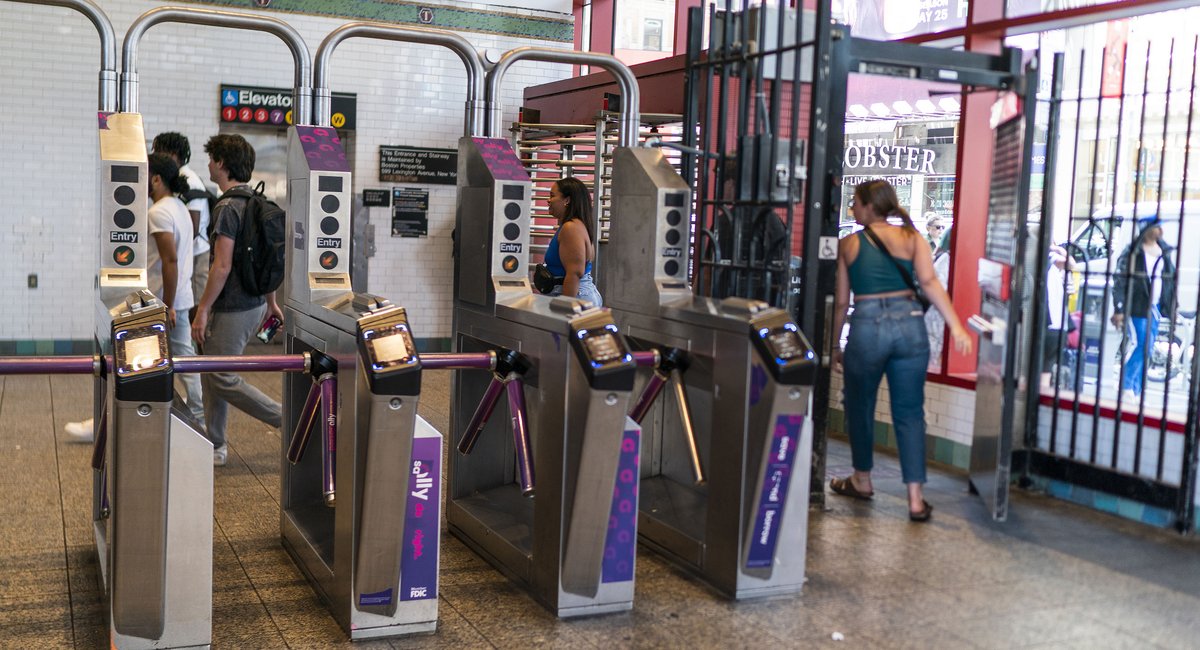This column originally appeared in On The Way, a weekly newsletter covering everything you need to know about NYC-area transportation.
Sign up to get the full version, which includes answers to reader questions, trivia, service changes and more, in your inbox every Thursday.
New York City taxpayers could be on the hook for cost of fare and toll scofflaws
Fare and toll evasion has skyrocketed in New York City since the COVID pandemic, and a new report from budget experts warns that New York taxpayers may face rising costs due to the scofflaws’ free rides.
The Citizens Budget Commission sounded the alarm this week, saying that the MTA likely lost more than $700 million to people who skipped the agency’s transit fares or evaded tolls at bridges and tunnels in 2023. It likened the financial hit “to the amount of funding that would be raised through two rounds of fare hikes.”
The report comes as the NYPD and MTA officials have argued that cracking down on fare evasion is a matter of public safety. They say that many perpetrators of violence in the system also don’t pay the fare. The Citizens Budget Commission wrote that widespread fare-beating also carries a significant economic cost that could trickle down to law-abiding users of public transit.
Ana Champeny, the commission’s vice president of research, said the annual cost of fare and toll evasion has grown by roughly $400 million since 2020. And as the number of riders who pay to ride trains and buses lags behind the MTA’s projections, she warned that transit officials and state lawmakers may look to raise fares, tolls and taxes.
“Ultimately, someone is having to pay the cost. And for those riders and drivers who are continuing to do the right thing and pay their fares and pay their tolls, they may ultimately have to bear a larger cost,” Champeny said.
The report notes that the problem of fare and toll evasion isn’t exclusive to the transit agency. The city Department of Transportation lost upwards of $100 million last year to drivers who obscured their plates to avoid automated camera tickets. The Port Authority estimates it lost $40 million in unpaid tolls. The report also found that the state Thruway Authority “struggled to collect $276 million in unpaid tolls and fees,” nearly half of which were from out-of-state commuters.
Champeny warned that the expected launch of congestion pricing could result in even more drivers covering their license plates to avoid new toll readers in Manhattan south of 60th Street.
In its report, the Citizens Budget Commission calls for state lawmakers to swiftly crack down on all forms of toll and fare evasion, and points to proposals included in Gov. Kathy Hochul’s executive budget as potential solutions.
One proposal would issue a written warning to anyone caught evading a transit fare for the first time, but would double their fine from $100 to $200 if they’re caught again. Another would forgive fare evasion fines issued to people who are eligible for the city’s Fair Fares program, which offers half-priced MetroCards to low-income residents — if they sign up for the deal after they’re busted jumping a turnstile. Other proposals would target toll scofflaws by increasing penalties for defaced or covered license plates.
Albany lawmakers are still discussing the slate of proposals as they negotiate a new state budget, which is already nearly a week late.
Assembly Speaker Carl Heastie told reporters on Tuesday that a crackdown on toll evasion was still on the table, but didn’t get into specifics.
Mayor Eric Adams announced last week that he’d dispatch 800 more police officers into public transit to crack down on fare evasion. The MTA is looking to redesign turnstiles across the subway to make it harder to beat the fare, but that effort is still in its early stages. Fare-beaters, meanwhile, keep clowning the MTA’s efforts to prevent them from taking yet another free ride.
Curious Commuter
Question
Why do trains go so slowly over the Williamsburg Bridge? It takes seven minutes to go from Marcy Avenue to Delancey on the M train.
– KB, Queens
The MTA literally slowed trains down on the Williamsburg Bridge nearly 30 years ago following a deadly subway crash. In June 1995, a J train ran full speed into an M train that was stopped on the bridge, killing the motorman in the front car and injuring dozens of riders. Investigators later found the J train driver fell asleep, and that signal equipment on the bridge failed to trip the runaway train’s emergency brakes. In the following years, the MTA reformed its safety practices, upgraded its signals and ordered lower speed limits for trains on the crossing (as well as dozens of other areas across the subway system). The MTA has increased some of those speed limits over the last six years. But for now, trains still move at a relatively sluggish pace across the Williamsburg Bridge.

Leave a Reply